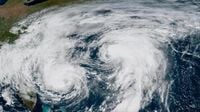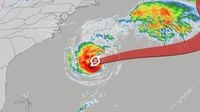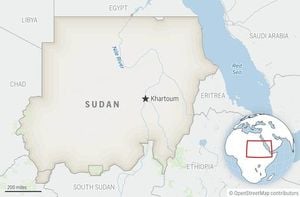As the Atlantic hurricane season rolled through its peak, Bermuda found itself at the center of a rare and perilous meteorological dance. In the span of just two days, the small British territory was battered by the outer bands of Hurricane Humberto and then braced for a far more direct—and dangerous—hit from Hurricane Imelda. The storms, unusually close in both time and distance, brought a cascade of challenges and a series of remarkable atmospheric phenomena that left communities from the Caribbean to the U.S. East Coast scrambling to respond.
According to the U.S. National Hurricane Center, Hurricane Imelda was a Category 2 storm with sustained winds reaching 100 mph as it barreled toward Bermuda on Wednesday. The hurricane’s core was expected to make a direct hit or pass just south of the islands late Wednesday, prompting a hurricane warning and urgent calls for residents to shelter in place. The Bermuda Weather Service warned that the island could endure sustained hurricane-force winds for up to six hours starting late Wednesday, with higher gusts and the risk of flash flooding. “I cannot overstate the seriousness of this threat,” Michael Weeks, Bermuda’s minister of national security, emphasized. “This is not, I must stress, a passing squall.”
Preparations on the island were swift and comprehensive. By Wednesday morning, Bermuda’s public schools and international airport had closed, and government offices and businesses were expected to follow suit by the afternoon. More than 340 customers were already without power as the first bands of Imelda approached, according to government reports. Residents were urged to complete all storm preparations by noon, with Weeks cautioning, “Imelda has the potential to damage and disrupt our island significantly.”
The timing of Imelda’s arrival was all the more unsettling because it followed so closely on the heels of Hurricane Humberto. On Tuesday, Humberto passed well west of Bermuda as a large hurricane, its outer bands lashing the island with gusts as high as 58 mph at the National Museum of Bermuda and widespread gusts between 40 and 50 mph elsewhere. Though Humberto’s impact was less severe than Imelda’s forecast, it still brought rain, dangerous surf, and beach erosion, setting the stage for further damage when Imelda arrived. By Wednesday morning, Humberto had lost its tropical status as it merged with a front over the ocean, but its legacy lingered in the form of rough seas and destabilized coastal infrastructure.
Bermuda’s vulnerability was heightened by the extraordinary proximity of the two storms. Hurricane expert Michael Lowry noted that Humberto and Imelda were separated by only about 450 miles on Tuesday—one of the 10 closest pairs of named Atlantic storms since the advent of satellite tracking in 1966. In fact, according to Lowry, the 467-mile gap between the two hurricanes earlier in the week was the closest recorded between two Atlantic hurricanes since 1853. This proximity set the stage for a rare atmospheric interaction known as the Fujiwhara Effect, in which the storms began to rotate around each other. As AccuWeather’s lead hurricane expert Alex DaSilva explained, Humberto’s presence actually pulled Imelda away from the U.S. East Coast, sparing the Southeast from a possible landfall.
But the effects of both storms were felt far beyond Bermuda. Along the U.S. East Coast, from Florida’s Space Coast to North Carolina’s Outer Banks, dangerous surf, rip currents, and coastal flooding became the norm. The National Park Service reported that at least six homes collapsed into the ocean on North Carolina’s Outer Banks by Tuesday, the result of relentless waves and erosion that left little buffer between the homes and the sea. The park service warned of hazardous debris and the ongoing risk of further collapses as high tides and storm surges continued.
Imelda’s destructive reach extended southward as well. Earlier in the week, the storm unleashed widespread flooding in eastern Cuba, where two people were killed and more than 18,000 people were evacuated in Guantánamo province. Flooding and landslides cut off access to 17 communities in Santiago de Cuba, isolating over 24,000 residents, according to state reports. In Haiti, authorities reported one person missing and two injured following heavy flooding in the southwest and northwest regions. Imelda also caused significant crop destruction in Haiti, a country already facing severe food insecurity for more than half its nearly 12 million inhabitants, as reported by local agencies.
The Bahamas were not spared either. Imelda flooded parts of New Providence, Grand Bahama, and Abaco, forcing the closure of more than a dozen schools and prompting Prime Minister Philip Davis to note, “The aftermath is serious. Floodwaters remain.”
Even as Imelda bore down on Bermuda, the remnants of Humberto were not finished making headlines. After merging with a cold front, Humberto’s leftover energy was forecast to trigger a powerful storm system—named "Storm Amy" by the U.K. Met Office—that would barrel into Ireland and the United Kingdom, potentially reaching bomb cyclone status with destructive winds and heavy rain. This transatlantic journey underscored the far-reaching impacts of these powerful systems, which often continue to influence weather patterns long after their tropical characteristics dissipate.
For the United States, the 2025 Atlantic hurricane season has been, in some ways, a reprieve—at least so far. According to AccuWeather, this marks the first time in a decade that no hurricane had made landfall in the U.S. through the end of September. Only Tropical Storm Chantal managed a U.S. landfall earlier in the year. Yet, as DaSilva warned, “We expect atmospheric conditions that could support tropical storms and hurricanes well into late October and November this year.” The National Oceanic and Atmospheric Administration had predicted an above-normal season, with 13 to 18 named storms, five to nine hurricanes, and two to five major hurricanes packing winds of 111 mph or greater.
As Imelda’s core approached Bermuda late Wednesday, forecasters anticipated up to four inches of rain, a dangerous storm surge, and large, battering waves. The hurricane was expected to move into the North Atlantic on Thursday and transition into a non-tropical low, but not before leaving its mark on the island and the broader region. The Atlantic hurricane season, which runs from June 1 to November 30, is far from over—and as the events of this week have shown, even seasoned, storm-tested communities can find themselves in the crosshairs of nature’s most unpredictable forces.
With two hurricanes passing in such close succession and a rare atmospheric phenomenon at play, Bermuda and its neighbors have been reminded just how quickly the weather can turn—and how vital preparation and vigilance remain in the face of nature’s fury.






